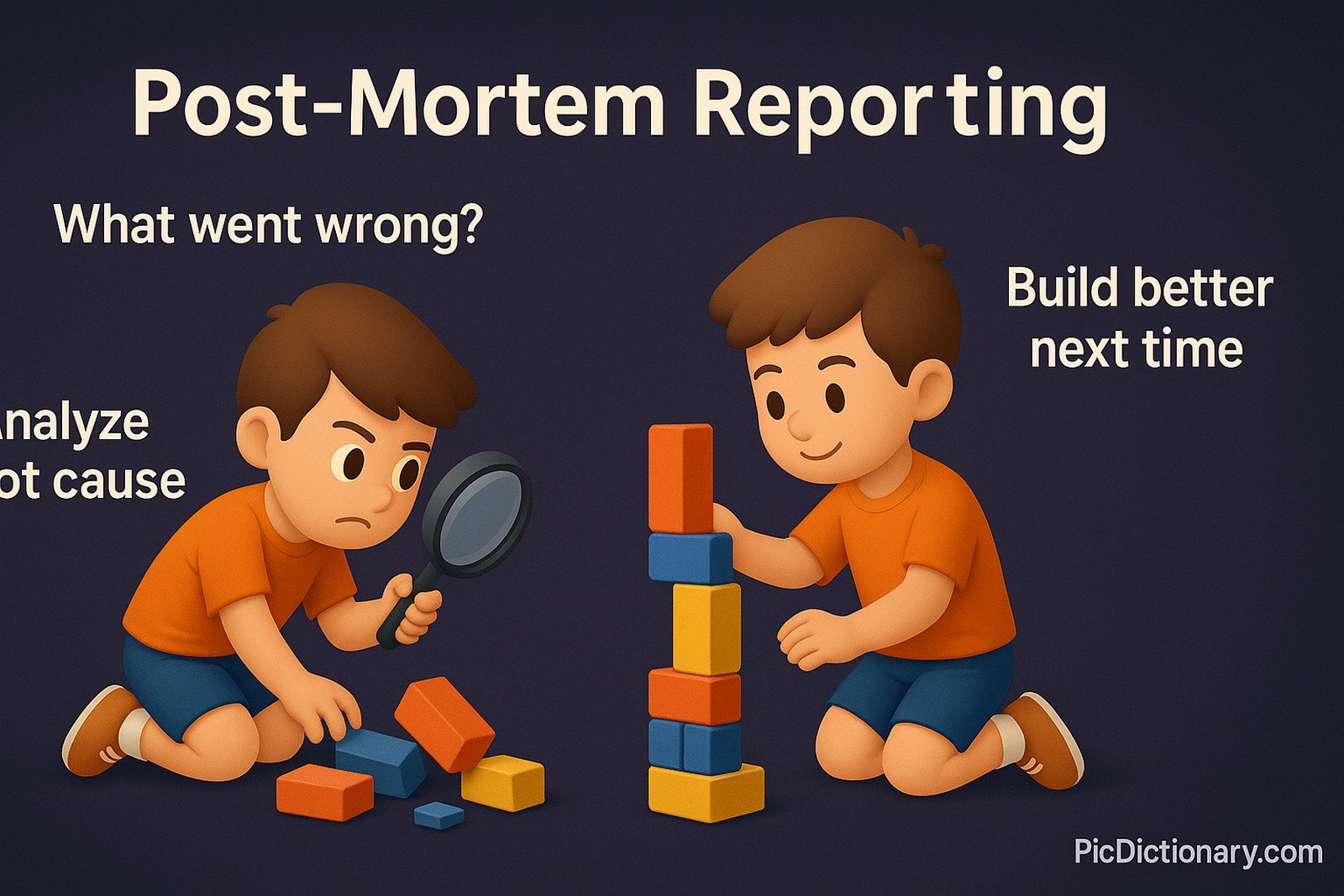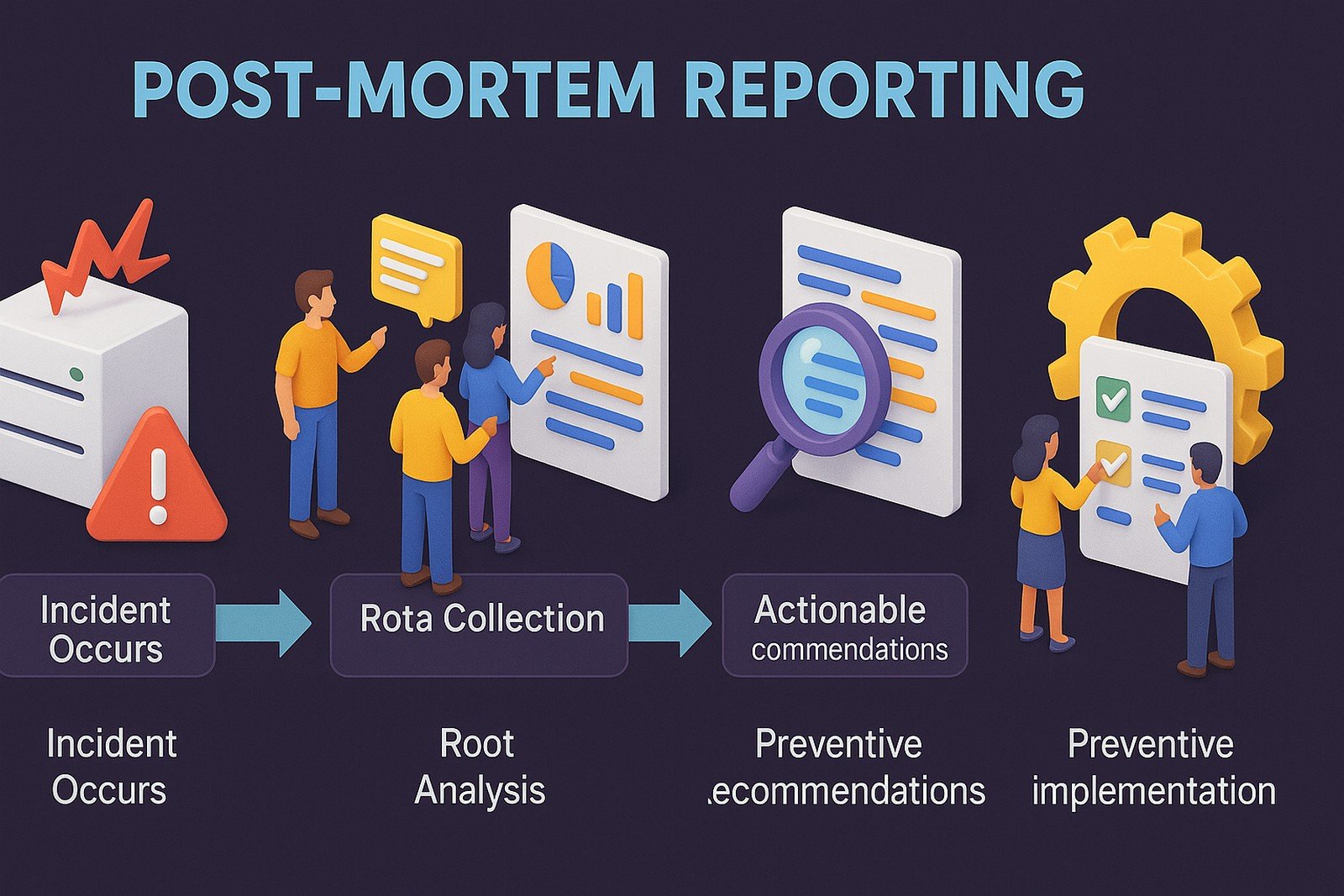Post-Mortem Reporting

Quick Navigation:
- Post-Mortem Reporting Definition
- Post-Mortem Reporting Explained Easy
- Post-Mortem Reporting Origin
- Post-Mortem Reporting Etymology
- Post-Mortem Reporting Usage Trends
- Post-Mortem Reporting Usage
- Post-Mortem Reporting Examples in Context
- Post-Mortem Reporting FAQ
- Post-Mortem Reporting Related Words
Post-Mortem Reporting Definition
Post-mortem reporting is a structured process in software development used to analyze and document the causes of system failures, incidents, or project outcomes. It involves identifying contributing factors, assessing their impact, and creating actionable recommendations to prevent recurrence. This reporting is common in IT operations, DevOps, and Agile workflows, where teams document failures for continuous improvement.
Post-Mortem Reporting Explained Easy
Imagine you built a tower out of blocks, but it fell over. Instead of just rebuilding, you take a closer look—maybe one block was too small, or the base wasn’t strong enough. You figure out what went wrong so that next time, your tower stands tall. That’s what post-mortem reporting does for software—it helps teams learn from mistakes to build better systems.
Post-Mortem Reporting Origin
The concept of post-mortem reporting originates from military and medical practices, where debriefing after events was used to understand outcomes. In software, this practice became widespread in IT operations and project management to improve reliability and efficiency.
Post-Mortem Reporting Etymology
The term “post-mortem” comes from Latin, meaning “after death.” In software, it signifies an analysis conducted after an incident or failure to determine what happened and how to avoid similar issues.
Post-Mortem Reporting Usage Trends
With the rise of Agile development, DevOps, and Site Reliability Engineering (SRE), post-mortem reporting has become an essential practice in IT. Tech giants like Google and Netflix emphasize blameless post-mortems, encouraging open discussions to improve systems without punishing individuals. Companies increasingly use automation and AI to assist in post-mortem analysis, reducing human error in failure assessments.
Post-Mortem Reporting Usage
- Formal/Technical Tagging:
- Incident Management
- Software Development
- IT Operations - Typical Collocations:
- "blameless post-mortem"
- "incident post-mortem report"
- "post-mortem analysis"
- "software failure post-mortem"
Post-Mortem Reporting Examples in Context
- A cloud service provider conducts a post-mortem report after a system outage to identify the root cause.
- A software company holds a blameless post-mortem meeting after a failed product launch.
- An IT team documents a security breach post-mortem to strengthen their cybersecurity measures.
Post-Mortem Reporting FAQ
- What is post-mortem reporting in software development?
Post-mortem reporting is a structured process used to analyze software failures and prevent future incidents. - Why is post-mortem reporting important?
It helps teams learn from failures, improve reliability, and avoid repeating mistakes. - What is a blameless post-mortem?
A blameless post-mortem focuses on learning from mistakes rather than assigning blame, encouraging openness. - What are the key components of a post-mortem report?
A report typically includes an incident summary, root cause analysis, impact assessment, and action items. - Who should be involved in a post-mortem analysis?
Developers, operations teams, and stakeholders impacted by the incident should participate. - When should a post-mortem be conducted?
It should be held soon after an incident while details are fresh. - How do you write an effective post-mortem report?
Clearly document the timeline, causes, and recommended actions while maintaining an objective tone. - Can post-mortem reports help prevent cybersecurity incidents?
Yes, they help identify vulnerabilities and strengthen security measures. - What tools can assist in post-mortem reporting?
Tools like JIRA, Confluence, and dedicated incident management platforms streamline the process. - Is post-mortem reporting used outside software development?
Yes, industries like healthcare, aviation, and manufacturing use post-mortem reviews to improve processes.

Post-Mortem Reporting Related Words
- Categories/Topics:
- Incident Analysis
- IT Operations Management
- DevOps
Did you know?
The Mars Climate Orbiter, a NASA spacecraft, was lost in 1999 due to a metric conversion error between software teams. A post-mortem report revealed the mistake and led to improved communication protocols in space missions.
PicDictionary.com is an online dictionary in pictures. If you have questions or suggestions, please reach out to us on WhatsApp or Twitter.Authors | Arjun Vishnu | @ArjunAndVishnu

I am Vishnu. I like AI, Linux, Single Board Computers, and Cloud Computing. I create the web & video content, and I also write for popular websites.
My younger brother, Arjun handles image & video editing. Together, we run a YouTube Channel that's focused on reviewing gadgets and explaining technology.



Comments powered by CComment